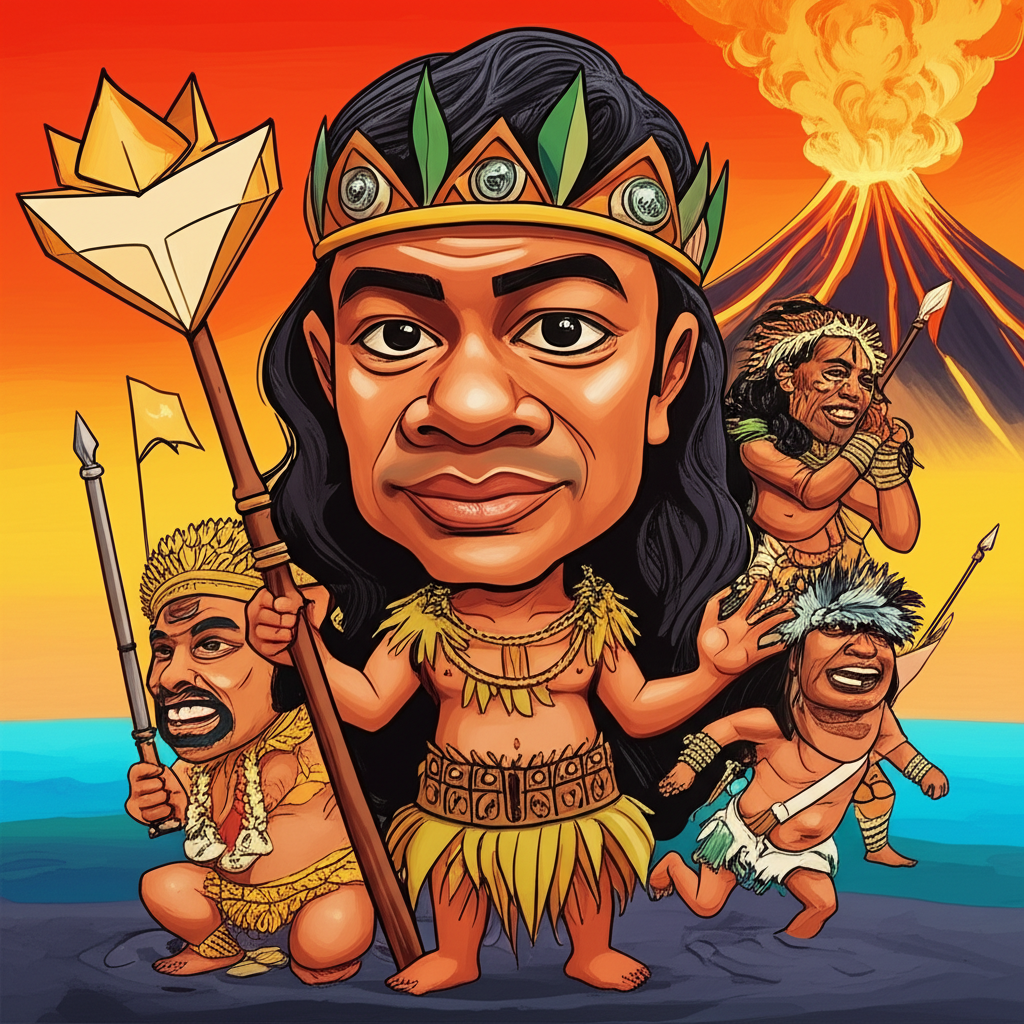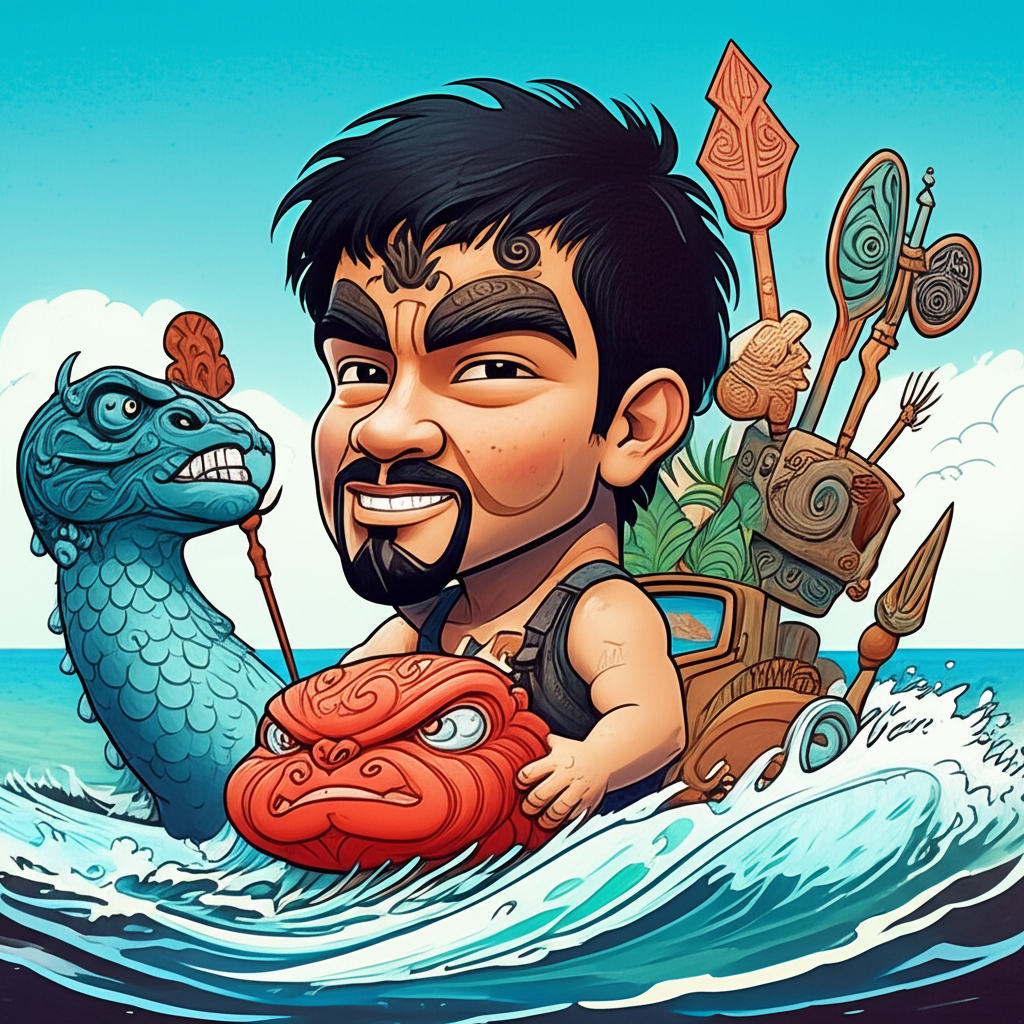
1. Introduction
The Hawaiian Islands, born of fire and ocean, are steeped in a rich tapestry of myths and legends, passed down through generations. Among these captivating narratives is the tale of the Huakaʻi Pō, or Nightmarchers, a phenomenon deeply embedded in the islands’ folklore. This is a traditional story told by the ancient people of Hawaiʻi, a cultural narrative that speaks to their profound connection with the land, their ancestors, and the unseen world. It is presented here purely for cultural, historical, and educational understanding, recognizing it as a product of human imagination and ancient worldview, not as truth to be believed or practiced.
2. Origins and Cultural Background
The myth of the Nightmarchers originates from pre-contact Hawaiʻi, a period before European arrival, when the islands were governed by a complex social structure and a deep spiritual connection to nature. In this era, Hawaiian society was highly stratified, ruled by a powerful class of aliʻi (chiefs) and guided by kahuna (priests and experts). Life revolved around the rhythms of the land and sea, sustained by sophisticated agricultural practices and skilled fishing.
For the people of ancient Hawaiʻi, the world was alive with spiritual energy, or mana. Every element of nature—from the towering volcanoes and the lush rainforests to the crashing waves and the celestial bodies—was imbued with divine power and often personified by gods and goddesses. The landscape itself was considered sacred, a living entity that reflected the genealogies of their ancestors and deities. The concept of kapu, a system of sacred laws and prohibitions, maintained social order and ensured respect for these powerful forces, governing everything from resource management to interactions with the divine. It was within this worldview, where the veil between the living and the ancestral realm was thin, that the legends of the Nightmarchers took root.
3. Character / Creature Description
The Huakaʻi Pō, or Nightmarchers, are described as spectral processions of ancient Hawaiian warriors, chiefs, and royalty, forever treading the pathways of their sacred past. They are not living beings but rather ethereal echoes, spirits of the departed who once held great mana in life. When encountered, they are said to appear in full ancient regalia: feathered helmets (mahiole) and cloaks (ʻahuʻula), carrying spears (pololū) and ancient weapons. Their march is heralded by the distant, rhythmic beating of ancient drums (pahu), the mournful blast of conch shells (pū), and the eerie chanting of their procession. Torches (lama) carried by the marchers cast an otherworldly glow, illuminating their path through the darkest hours of the night.
While the Nightmarchers themselves are the central figures, the legend also intertwines with other powerful deities. The mention of "Echoes of Hina" in this context can be interpreted symbolically. Hina is a prominent Hawaiian goddess, often associated with the moon, kapa making, and feminine power. Her presence in the Nightmarcher narrative might symbolize the moon’s guiding light, under which these ancient spirits often travel, or represent the enduring ancestral lineage and the deep, creative power of the islands that the Nightmarchers embody. Furthermore, their journey often takes them across the volcanic landscapes, the very domain of Pele, the goddess of fire and volcanoes. These powerful natural features are not just backdrops; they are sacred arteries of the land, resonating with the same ancient mana that drives the Nightmarchers, making the volcanoes gateways and destinations for these spectral parades. The Nightmarchers are thus symbolic guardians of the old ways, a stark reminder of the kapu and the profound reverence due to the land and its history.
4. Main Story / Narrative Retelling
The legend of the Huakaʻi Pō is not a single, linear tale, but rather a collection of shared experiences and warnings, woven into the fabric of Hawaiian oral tradition. It tells of those rare, unsettling nights when the veil between worlds thins, and the echoes of ancient Hawaiʻi manifest.
Imagine a night on the slopes of Mauna Loa, under a full moon, its silver light spilling over the hardened lava flows. A lone traveler, perhaps a fisherman returning late or a hunter venturing into the uplands, finds themselves far from the comfort of their village. The air grows heavy, charged with an inexplicable energy. A faint, distant sound begins to drift on the breeze – a low, guttural chant, almost imperceptible at first, accompanied by a rhythmic thumping. It grows steadily louder, joined by the mournful, resonant blast of a conch shell that seems to vibrate through the very ground.
A chill runs down the traveler’s spine. They know these sounds. They are the unmistakable harbingers of the Huakaʻi Pō. Panic, mixed with a profound sense of awe, grips them. The wise elders had always warned: if you hear the Nightmarchers approaching, do not look. Do not speak. Do not draw attention to yourself. Seek immediate shelter, lie prostrate on the ground, or hide behind a tree or rock, averting your gaze. To meet their eyes, to show disrespect, or to attempt to interact with them, invites dire consequences – a swift, ghostly demise, or being compelled to join their eternal march.
As the sounds intensify, the rhythmic thump-thump-thump of ancient drums grows deafening, and the chants swell into a powerful chorus. Then, through the dense foliage or across the open lava fields, a flickering light appears – torches, dozens of them, moving in a silent, disciplined line. The traveler, perhaps peeking through parted leaves, witnesses the procession. Tall, imposing figures adorned in ancient warrior regalia stride with purpose, their faces obscured by shadows or perhaps already faded by time. Some carry standards, others beat drums with unearthly precision, while others blow conch shells whose sound reverberates through the very bones. At the heart of the procession, it is said, might be a kahili (feather standard) marking the presence of a high-ranking aliʻi, a chief or chieftainess of immense mana.
The marchers move with an unhurried, inexorable pace, often following ancient trails that are now overgrown or paved over, or even traversing the slopes of Kīlauea and Mauna Loa, their path dictated by unseen forces and forgotten purposes. They pass by, an unbroken line of spectral glory and terrifying power, their eyes fixed on a destination known only to them. The air crackles with their mana, a raw, ancient energy that washes over the observer. Then, as suddenly as they appeared, the last torchbearer passes, the chants fade, the drums soften to a whisper, and the conch’s echo dies away into the vast silence of the Hawaiian night. The traveler is left trembling, forever changed by the fleeting glimpse into the islands’ powerful, unyielding past.
5. Symbolism and Meaning
To the ancient Hawaiians, the legend of the Nightmarchers was far more than a scary story; it was a potent tapestry of symbolism and meaning. At its core, the Huakaʻi Pō represented the enduring presence of the ancestors and the sacredness of the land. Their appearance served as a vivid reminder that the past was not truly gone but coexisted with the present, and that the spirits of powerful aliʻi and warriors continued to walk their ancestral lands.
The march also reinforced the profound importance of kapu and proper conduct. The strict protocols for encountering the Nightmarchers—to lie prostrate, avoid eye contact, and remain silent—underscored the absolute necessity of respect for those of higher mana, both living and deceased. Disregarding these rules could lead to fatal consequences, thereby acting as a powerful moral lesson about humility, reverence, and adherence to social and spiritual laws.
Furthermore, the Nightmarchers symbolized the raw, untamed power of nature, particularly the volcanoes. Their passage through these sacred, fiery landscapes connected them intrinsically to Pele, the goddess of fire, and the dynamic forces that shaped the islands. It suggested that even the land itself held ancient memories and energies that demanded respect. The Nightmarchers were also an embodiment of fear, but a fear tempered with reverence—a fear of the unknown, of the sacred, and of the potent forces that lay just beyond human perception. They were a living, breathing (or rather, non-breathing) testament to the rich, spiritual heritage of Hawaiʻi, an echo of a powerful, ancient world.
6. Modern Perspective
Today, the legend of the Nightmarchers continues to captivate and intrigue, evolving from a cautionary tale into a significant element of Hawaiian cultural identity. In modern Hawaiʻi, the stories are primarily shared for cultural preservation, historical understanding, and as a powerful narrative that connects contemporary Hawaiians to their ancestral roots. While not widely believed as a literal phenomenon in the same way by all residents, the respect for the legend remains strong.
The Nightmarchers have found their way into various forms of contemporary media and cultural discourse. They appear in local literature, inspiring stories and poems that explore themes of heritage, spirituality, and the enduring power of the past. References to them can be found in films and television shows set in Hawaiʻi, often used to add a layer of indigenous mystique and to ground narratives in local folklore. Video games and other interactive media sometimes incorporate elements of the Nightmarchers, allowing players to encounter or learn about this unique cultural phenomenon.
In tourist contexts, the legend is often shared as an interesting piece of local lore, with tour guides recounting tales and explaining the traditional protocols for encountering them. This often serves as a subtle reminder for visitors to respect the sacredness of the land and local customs. Academics and cultural scholars study the Nightmarcher legends as rich sources of information about ancient Hawaiian cosmology, social structures, and moral codes. For many, the Nightmarchers are a powerful symbol of Hawaiian sovereignty, resilience, and the unyielding spirit of the ancestors who continue to watch over their beloved islands.
7. Conclusion
The legend of the Huakaʻi Pō, or Nightmarchers, stands as a profound testament to the power of storytelling and the deep spiritual connection of the ancient Hawaiians to their land and ancestors. It is a cultural narrative, a product of human imagination and a specific worldview, passed down through generations not as literal truth, but as a vessel for history, values, and identity. As Muslims, we recognize that only Allah is the true Creator and Sustainer of all existence, and that all power and authority belong to Him alone. We understand that such mythological tales, while rich in cultural significance, are distinct from divine revelation.
Nevertheless, the echoes of Hina and the silent march of the Nightmarchers across the Hawaiian volcanoes offer us a fascinating glimpse into a vibrant cultural heritage. They remind us of humanity’s universal need to explain the world around us, to honor our past, and to find meaning in the unseen. Through such stories, we appreciate the boundless capacity of the human mind to imagine, to create, and to preserve traditions that continue to resonate across time and inspire respect for the diverse narratives that enrich our global tapestry.





